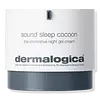What's inside
What's inside
 Key Ingredients
Key Ingredients

 Benefits
Benefits

 Concerns
Concerns

 Ingredients Side-by-side
Ingredients Side-by-side

Water
Skin ConditioningDimethicone
EmollientGlycerin
HumectantPropanediol
SolventPolymethylsilsesquioxane
Albizia Julibrissin Bark Extract
MaskingDimethicone/PEG-10/15 Crosspolymer
Sodium Chloride
MaskingEvodia Rutaecarpa Fruit Extract
Skin ConditioningLavandula Hybrida Abrial Herb Oil
PerfumingTocopheryl Acetate
AntioxidantTerminalia Ferdinandiana Fruit Extract
AntioxidantCaprylhydroxamic Acid
Trisodium Ethylenediamine Disuccinate
Tamarindus Indica Seed Polysaccharide
Skin ConditioningDipropylene Glycol
HumectantLavandula Angustifolia Flower Extract
CleansingEthylhexylglycerin
Skin ConditioningFusanus Spicatus Wood Oil
MaskingPogostemon Cablin Leaf Oil
MaskingSodium Citrate
BufferingPEG-10 Dimethicone
Skin ConditioningHexanediol
SolventPolyurethane Crosspolymer-1
Limonene
PerfumingTocopherol
AntioxidantCitric Acid
BufferingLinalool
PerfumingPhenoxyethanol
PreservativeWater, Dimethicone, Glycerin, Propanediol, Polymethylsilsesquioxane, Albizia Julibrissin Bark Extract, Dimethicone/PEG-10/15 Crosspolymer, Sodium Chloride, Evodia Rutaecarpa Fruit Extract, Lavandula Hybrida Abrial Herb Oil, Tocopheryl Acetate, Terminalia Ferdinandiana Fruit Extract, Caprylhydroxamic Acid, Trisodium Ethylenediamine Disuccinate, Tamarindus Indica Seed Polysaccharide, Dipropylene Glycol, Lavandula Angustifolia Flower Extract, Ethylhexylglycerin, Fusanus Spicatus Wood Oil, Pogostemon Cablin Leaf Oil, Sodium Citrate, PEG-10 Dimethicone, Hexanediol, Polyurethane Crosspolymer-1, Limonene, Tocopherol, Citric Acid, Linalool, Phenoxyethanol
Water
Skin ConditioningButylene Glycol
HumectantGlycerin
HumectantSqualane
EmollientButyrospermum Parkii Butter
Skin ConditioningCaprylic/Capric Triglyceride
MaskingPalmitic Acid
EmollientSimmondsia Chinensis Seed Oil
EmollientGlyceryl Stearate Se
EmulsifyingPropanediol
SolventHexyldecanol
EmollientPolyglyceryl-3 Methylglucose Distearate
EmulsifyingHydroxyacetophenone
AntioxidantDipotassium Glycyrrhizate
HumectantCentella Asiatica Extract
CleansingBoerhavia Diffusa Root Extract
Skin ProtectingMyrothamnus Flabellifolia Leaf/Stem Extract
HumectantTasmannia Lanceolata Leaf Extract
Skin ConditioningBrassica Campestris Sterols
EmollientZingiber Officinale Root Extract
MaskingTocopherol
AntioxidantLactobacillus Ferment
Skin ConditioningCetylhydroxyproline Palmitamide
Skin ConditioningCaprylyl Glycol
EmollientTriolein
Skin ConditioningMaltodextrin
AbsorbentBisabolol
MaskingXanthan Gum
EmulsifyingCetearyl Alcohol
EmollientMyristic Acid
CleansingTetrasodium Glutamate Diacetate
Hydroxystearic Acid
Cleansing1,2-Hexanediol
Skin ConditioningSodium Hydroxide
BufferingCitric Acid
BufferingSodium Polyacryloyldimethyl Taurate
Emulsion StabilisingAmmonium Acryloyldimethyltaurate/Vp Copolymer
Stearic Acid
CleansingAcacia Senegal Gum
MaskingWater, Butylene Glycol, Glycerin, Squalane, Butyrospermum Parkii Butter, Caprylic/Capric Triglyceride, Palmitic Acid, Simmondsia Chinensis Seed Oil, Glyceryl Stearate Se, Propanediol, Hexyldecanol, Polyglyceryl-3 Methylglucose Distearate, Hydroxyacetophenone, Dipotassium Glycyrrhizate, Centella Asiatica Extract, Boerhavia Diffusa Root Extract, Myrothamnus Flabellifolia Leaf/Stem Extract, Tasmannia Lanceolata Leaf Extract, Brassica Campestris Sterols, Zingiber Officinale Root Extract, Tocopherol, Lactobacillus Ferment, Cetylhydroxyproline Palmitamide, Caprylyl Glycol, Triolein, Maltodextrin, Bisabolol, Xanthan Gum, Cetearyl Alcohol, Myristic Acid, Tetrasodium Glutamate Diacetate, Hydroxystearic Acid, 1,2-Hexanediol, Sodium Hydroxide, Citric Acid, Sodium Polyacryloyldimethyl Taurate, Ammonium Acryloyldimethyltaurate/Vp Copolymer, Stearic Acid, Acacia Senegal Gum
 Reviews
Reviews

Alternatives
Ingredients Explained
These ingredients are found in both products.
Ingredients higher up in an ingredient list are typically present in a larger amount.
Citric Acid is an alpha hydroxy acid (AHA) naturally found in citrus fruits like oranges, lemons, and limes.
Like other AHAs, citric acid can exfoliate skin by breaking down the bonds that hold dead skin cells together. This helps reveal smoother and brighter skin underneath.
However, this exfoliating effect only happens at high concentrations (20%) which can be hard to find in cosmetic products.
Due to this, citric acid is usually included in small amounts as a pH adjuster. This helps keep products slightly more acidic and compatible with skin's natural pH.
In skincare formulas, citric acid can:
While it can provide some skin benefits, research shows lactic acid and glycolic acid are generally more effective and less irritating exfoliants.
Most citric acid used in skincare today is made by fermenting sugars (usually from molasses). This synthetic version is identical to the natural citrus form but easier to stabilize and use in formulations.
Read more about some other popular AHA's here:
Learn more about Citric AcidGlycerin is already naturally found in your skin. It helps moisturize and protect your skin.
A study from 2016 found glycerin to be more effective as a humectant than AHAs and hyaluronic acid.
As a humectant, it helps the skin stay hydrated by pulling moisture to your skin. The low molecular weight of glycerin allows it to pull moisture into the deeper layers of your skin.
Hydrated skin improves your skin barrier; Your skin barrier helps protect against irritants and bacteria.
Glycerin has also been found to have antimicrobial and antiviral properties. Due to these properties, glycerin is often used in wound and burn treatments.
In cosmetics, glycerin is usually derived from plants such as soybean or palm. However, it can also be sourced from animals, such as tallow or animal fat.
This ingredient is organic, colorless, odorless, and non-toxic.
Glycerin is the name for this ingredient in American English. British English uses Glycerol/Glycerine.
Learn more about GlycerinPropanediol is an all-star ingredient. It softens, hydrates, and smooths the skin.
It’s often used to:
Propanediol is not likely to cause sensitivity and considered safe to use. It is derived from corn or petroleum with a clear color and no scent.
Learn more about PropanediolTocopherol (also known as Vitamin E) is a common antioxidant used to help protect the skin from free-radicals and strengthen the skin barrier. It's also fat soluble - this means our skin is great at absorbing it.
Vitamin E also helps keep your natural skin lipids healthy. Your lipid skin barrier naturally consists of lipids, ceramides, and fatty acids. Vitamin E offers extra protection for your skin’s lipid barrier, keeping your skin healthy and nourished.
Another benefit is a bit of UV protection. Vitamin E helps reduce the damage caused by UVB rays. (It should not replace your sunscreen). Combining it with Vitamin C can decrease sunburned cells and hyperpigmentation after UV exposure.
You might have noticed Vitamin E + C often paired together. This is because it is great at stabilizing Vitamin C. Using the two together helps increase the effectiveness of both ingredients.
There are often claims that Vitamin E can reduce/prevent scarring, but these claims haven't been confirmed by scientific research.
Learn more about TocopherolWater. It's the most common cosmetic ingredient of all. You'll usually see it at the top of ingredient lists, meaning that it makes up the largest part of the product.
So why is it so popular? Water most often acts as a solvent - this means that it helps dissolve other ingredients into the formulation.
You'll also recognize water as that liquid we all need to stay alive. If you see this, drink a glass of water. Stay hydrated!
Learn more about Water